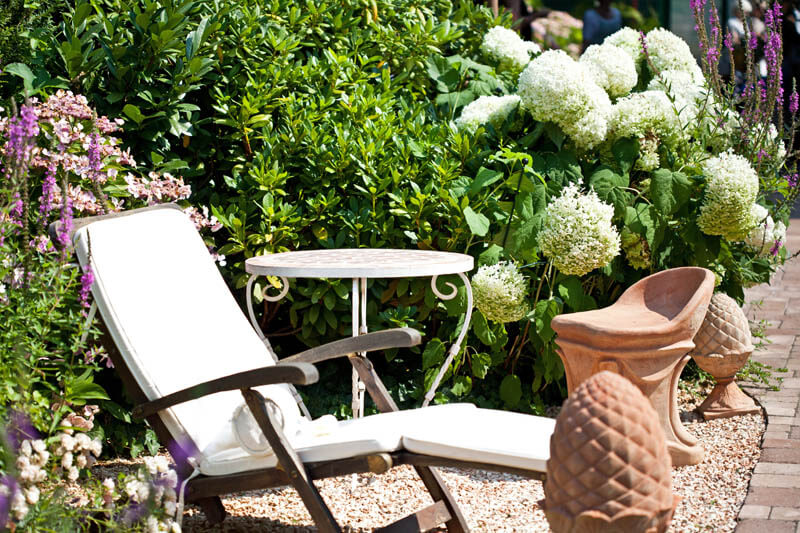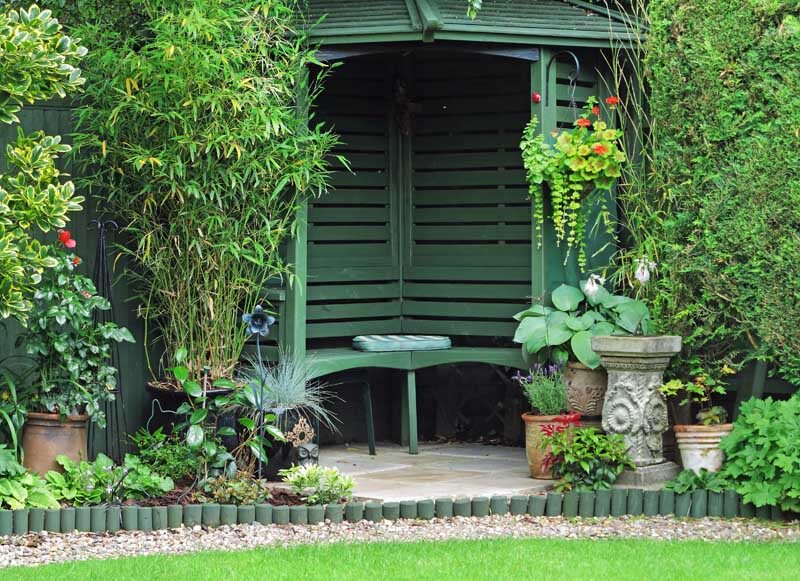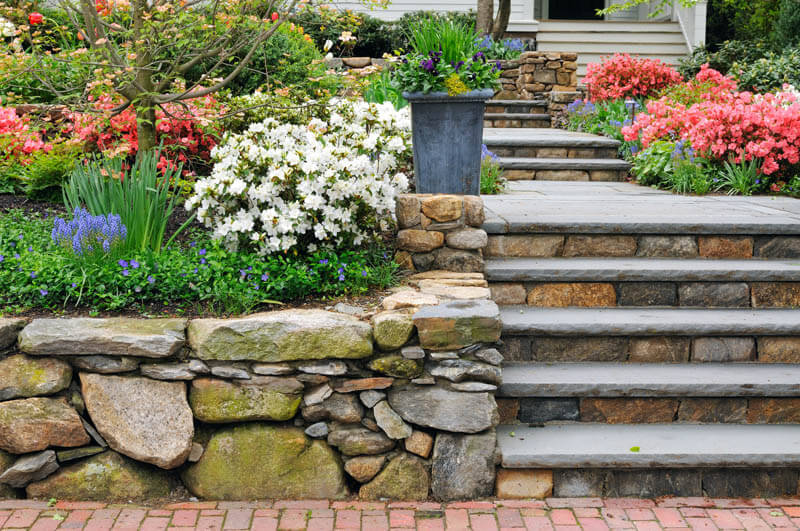

Artful garden blending is combining a diverse collection of plants, hardscaping, and art into a larger, living, inspiring work of art. The greatest gardeners are master blenders that work magic to bring a garden design idea to life.
The Gertrude Jekylls and Christopher Lloyds (two famed and accomplished garden designers) of this world are rare but given a few guidelines, most of us can create visually and emotionally satisfying beds, borders, and container gardens. Incorporate some artful elements and you can have perfect synchrony of color, texture, and structural elements.
Blending Style

Your approach to artfulness will depend on your individual style. Do you like formality, with crisp edges and well-defined spaces, or do you prefer something a little less restrained, with drifts of plants blending together in a naturalistic style? Your first steps may also depend on whether you are taking on a new bed or container array, or modifying one that is already established. If a planting scheme is already established and you don’t want to start over from scratch, look at it with a critical eye. Sometimes taking photos will help with this. Figure out what you like and don’t like. Does the big picture look like a mishmash of plants or an interesting composition? If it looks like a mishmash, it’s time to find ways to introduce some unifying themes or elements.
If your garden lacks cohesion, you can often solve the problem by introducing repetition. This can be as easy as going to the big box store and buying flats or large pots of annuals in a single neutral color, like white impatiens (for shady spots) or white cosmos (for sunny areas), and interspersing those plants throughout the bed or border. You can do the same thing with silver-leaved foliage plants like silver sage (Artemisia ‘Powis Castle’) or lambs’ ears (Stachys byzantina). Foliage plants have the added benefit of providing continuity that goes beyond flower color.
Repetition of textures is another technique that can bring about unity. The quilted leaves of some hostas sprinkled throughout a shade garden or drifts of catmint (Nepeta species and hybrids) in sunnier areas can knit plant collections together.
Displaying Plants with Art

Think about displaying plants to best advantage. For beds that back up to something solid—a fence, wall or tall hedge–place the tallest plants at the center back. Medium height plants go in the middle of the bed and short or ground-covering plants go in front. For circular beds or beds that will be seen from all sides, position the tallest, most striking specimens in the middle to create focal points. You can also use a distinctive shrub, small tree or a piece of garden art to do the same job.
Think about displaying plants to best advantage. For beds that back up to something solid—a fence, wall or tall hedge–place the tallest plants at the center back. Medium height plants go in the middle of the bed and short or ground-covering plants go in front. For circular beds or beds that will be seen from all sides, position the tallest, most striking specimens in the middle to create focal points. You can also use a distinctive shrub, small tree or a piece of garden art to do the same job.
Whenever you rearrange plants or add new ones to the garden, give them a good start by amending the soil with quality organic matter like Fafard® Garden Manure Blend. Healthy plants always make a more beautiful landscape.

Some artful gardeners unify planting schemes by emphasizing a single color. English gardener Vita Sackville West did this with her famous “White Garden” at Sissinghurst. Using many shades or tones of one color, combined with plant choices that allow for long seasons of interest, can create beautiful effects. Sometimes introducing a few specimens in a contrasting color adds sparkle.
Artists understand the color wheel and so should gardeners. To create excitement and unify beds or large containers, combine primary or secondary colors that are opposite each other on the color wheel—blue and orange, for example—and choose plants with leaves and/or flowers in shades of those colors. Mix brighter and lighter shades and use green as a neutral buffer, so that you garden doesn’t suffer from too much of a good thing.
You can also combine colors that are side by side on the color wheel, like shades of green, blue, and purple. Plants with purple or purple/black leaves, like Heuchera ‘Chocolate Ruffles’ or Ajuga ‘Black Scallop’, make especially useful accents. Some artful gardeners choose “hot” color schemes (red, yellow, orange) or “cool’ colors (blue, pink, and purple) to unify plantings.

If you have chosen sculptures, benches or other objects as focal points, use plants to highlight them. Flank a garden arch with a columnar shrub, like Sky Pencil holly (Ilex crenata ‘Sky Pencil’). Position pots of red cannas on either end of a garden bench and you will have created an eye-catching focal point for a summer garden. To avoid creating a sensory distraction, make sure that the surrounding plants are a little less dramatic.
If you are just starting out, remember to keep it simple. Think about seasons of interest. Depending on the size of the bed, border, or container, choose varieties that will bloom at different times during the growing season. Remember that leaves, stems, bark, seed pods and fruit all contribute to a plant’s overall aesthetic value. Nursery plant tags, catalog copy and internet references will help you figure this out.

And above all, don’t be afraid to take risks. Gardening is a forgiving art and planting “mistakes” can almost always be fixed by moving things around, introducing visual buffers or even giving away plants or decorative elements that don’t work. The definition of “artful blending” depends on the taste of the individual doing it.

